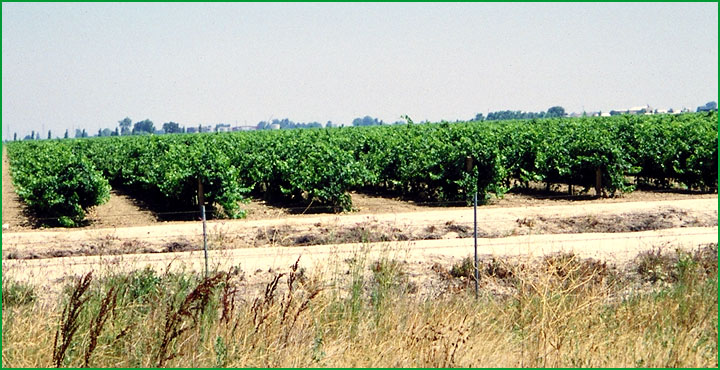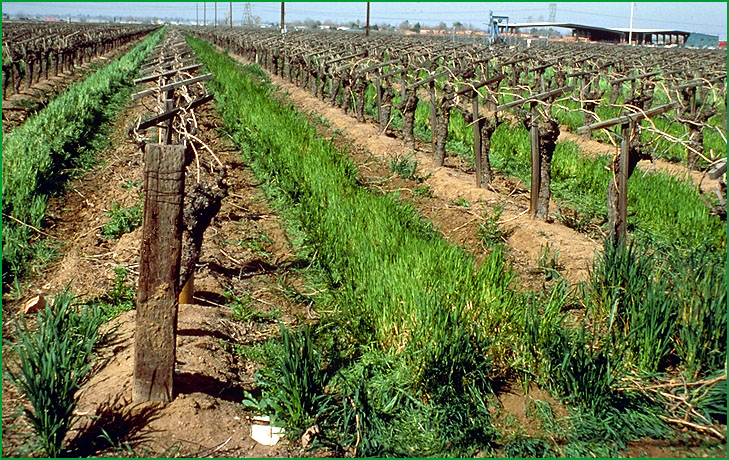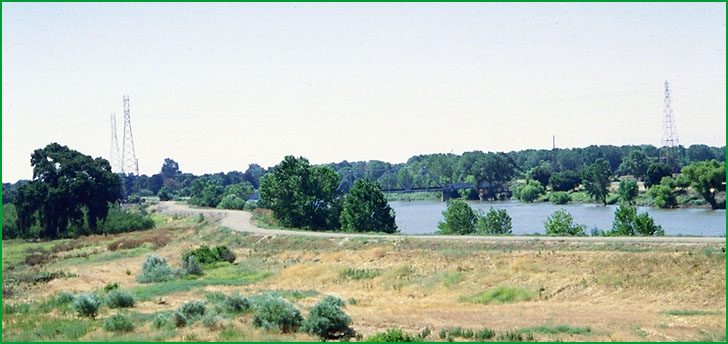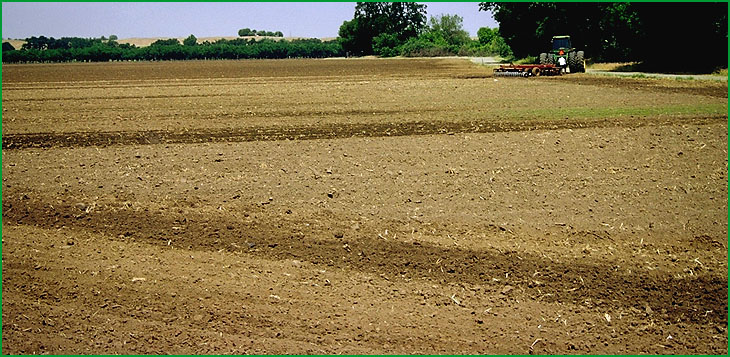 | Lodi Alluvium -Westside Alluvial Fans and Terraces- Caswell Basin -Manteca - Merced Alluvium |
Lodi Alluvium - vineyard in the Lodi area Ś Scott Miles |
Westside Alluvial Fans and Terraces-vineyard on Haplargid soil Ś Anon |
Caswell Basin - San Joaquin River area, south of Stockton Ś Scott Miles |
Caswell Basin - San Joaquin River area, south of Stockton Ś Patsy Miles |
Manteca - Merced Alluvium - northeast of Merced Ś Robert Ettner |
http://www.fs.fed.us/r5/projects/ecoregions/262ap.htm
Subsection 262Ap
Lodi Alluvium
This subsection is on nearly level to very gently sloping alluvial fans between the delta of the Sacramento and San Joaquin Rivers and terraces along the eastern edge of the Central Valley. The climate is hot and subhumid. MLRA 17e.
Lithology and Stratigraphy. This subsection contains recent alluvium. The alluvium is mostly from granitic rock sources, but some is from volcanic, sedimentary, and metamorphic rock sources.
Geomorphology. This subsection is on a nearly level to very gently sloping plain. It consists of the floodplains and alluvial fans of the Mokelumne and Calaveras Rivers and smaller streams. The subsection elevation range is about 20 to 100 feet. Fluvial erosion and deposition are the main geomorphic processes.
Soils. The soils are mostly Typic, Pachic, and Calcic Pachic Haploxerolls and Typic Haploxeralfs. Also, there are Fluventic Haploxerolls and Aquic Xerofluvents on floodplains. The soils are mostly well drained, but some on floodplains are somewhat poorly drained. Soil temperature regimes are thermic. Soil moisture regimes are mostly xeric, with some aquic.
Vegetation. The predominant natural plant communities are Needlegrass grasslands and Valley oak series. Fremont cottonwood series occurs along streams.
Characteristic series by lifeform include:
Grasslands: California annual grassland series, Purple needlegrass series.
Forests and woodlands: Fremont cottonwood series, Valley oak series.
Climate. The mean annual precipitation is about 16 to 18 inches. It is practically all rain. Mean annual temperature is about 59░ to 62░ F. The mean freeze-free period is about 250 to 275 days.
Surface Water. Streams in this subsection drain to the delta area of the Sacramento and San Joaquin Rivers. All but the larger streams are generally dry during the summer. There are no lakes
Subsection 262Aq
Westside Alluvial Fans and Terraces
This subsection is on terraces and alluvial fans along the western edge of the San Joaquin Valley, adjacent to Coast Ranges. The climate is hot and semi-arid to subhumid. MLRAs 15e, 15f, and 17e.
Lithology and Stratigraphy. This subsection contains mostly Quaternary alluvium, and some Plio-Pleistocene sediments. The alluvium is predominantly from sedimentary rocks sources in the Coast Ranges. There are small areas of Eocene, Miocene, and Pliocene sedimentary rocks.
Geomorphology. This subsection is on very gently to gently sloping terraces and alluvial fans. The San Joaquin Valley is asymmetrical, with shorter and steeper alluvial fans adjacent to the Coast Ranges than adjacent to the Sierra Nevada. Also, most of the drainage from the southern Coast Ranges is toward the Pacific Ocean, so there are few large streams draining across the terraces and alluvial fans on the west side of the San Joaquin Valley. The subsection elevation range is from 0 to about 1500 feet. Fluvial erosion and deposition are the main geomorphic processes.
Soils. The soils are Typic Xerofluvents, Typic and Calcixerollic Xerochrepts, Calcic and Aquic Haploxerolls, Typic and Mollic Haploxeralfs, Typic Chromoxererts, Typic and Chromic Pelloxererts, Aquic Natrixeralfs and Typic Palexeralfs. In drier areas near the southern end of the subsection there are Torriorthents, Camborthids, Haplargids, and Natrargids. Xeropsamments predominate in the Antioch dunes at the north end of the subsection. Most of the soils are well drained, but some are somewhat poorly well drained. Calcium carbonates, and even sodium, accumulate in some of the soils. Soil temperature regimes are thermic. Soil moisture regimes are xeric, and, in the southern end of the subsection, aridic.
Vegetation. The predominant natural plant communities are Needlegrass grasslands, and, in drier areas, California annual grass series. There are some Valley oak series and Northern claypan vernal pools.
Characteristic series by lifeform include:
Grasslands: California annual grassland series, Purple needlegrass series.
Vernal pools: Northern claypan vernal pools.
Shrublands: Bladderpod - California ephedra - narrowleaf goldenbush series.
Forests and woodlands: Stands at Antioch dunes, California sycamore series, Fremont cottonwood series.
Climate. The mean annual precipitation is about 8 to 16 inches. It is practically all rain. Precipitation increases both toward the mountains of the southern California Coast Ranges and toward the northern end of the subsection. Mean annual temperature is about 59░ to 62░ F. The mean freeze-free period is about 250 to 275 days.
Surface Water. Streams in this subsection drain to the San Joaquin River. All but the larger streams are generally dry during the summer. There are no lakes, but there is temporary ponding in vernal pools on Pleistocene terraces.
Subsection 262Ar
Caswell Basin
This subsection is on the floodplain of the San Joaquin River just upstream from the delta area. The climate is hot and subhumid. MLRA 17e.
Lithology and Stratigraphy. This subsection contains recent alluvium.
Geomorphology. This subsection is on nearly level floodplain and basin floors, and on some alluvial fans along the western edge of the subsection. The subsection elevation range is from less than 10 to about 60 feet. Fluvial erosion and deposition are the main geomorphic processes.
Soils. The soils are mostly Fluvaquentic Haploxerolls, Aquic Xerofluvents, and Cumulic Haplaquolls. There are small areas of Natrixeralfs, Durixeralfs, and Pelloxererts. The soils are mostly poorly drained and some are moderately well and well drained. Soil temperature regimes are thermic. Soil moisture regimes are mostly aquic, and some are xeric.
Vegetation. The predominant natural plant communities are Emergent aquatic communities. Fremont cottonwood series occurs along streams. Valley oak series occurs on well and moderately well drained soils.
Characteristic series by lifeform include:
Wetlands: Bulrush series, Bulrush - cattail series, Cattail series, Ditch-grass series, Sedge series.
Forests and woodlands: Fremont cottonwood series, Mixed willow series, Valley oak series.
Climate. The mean annual precipitation is about 10 to 12 inches. It is practically all rain. Mean annual temperature is about 59░ to 62░ F. The mean freeze-free period is about 250 to 275 days.
Surface Water. The San Joaquin River overflows onto this area. The subsection is drained by the San Joaquin River and its overflow channels. There are no permanent lakes
Subsection 262As
Manteca - Merced Alluvium
This subsection is on alluvial fans and flood plains of streams that cross the fans from the Sierra Nevada to reach the San Joaquin River. The climate is hot and subhumid. MLRA 17e.
Lithology and Stratigraphy. This subsection contains mostly late Quaternary alluvium. The alluvium is predominantly from granitic rock sources in the southern Sierra Nevada.
Geomorphology. This subsection is on very gently to gently sloping floodplains and alluvial fans along and between streams that cross from mountains of the Sierra to reach the San Joaquin River. The subsection elevation range is from 20 to about 180 feet. Fluvial erosion and deposition are the main geomorphic processes.
Soils. The soils are mostly in Typic subgroups of Xeropsamments, Xerorthents, Haploxerolls, and Haploxeralfs. Natric Durixeralfs are common in the drier south end of the subsection. Soils on floodplains along the main rivers are mostly Fluventic Haploxerolls and Aquic Xerofluvents. The soils are well drained, except for Aeric Haplaquepts on alluvial fans. Bicarbonate weathering and leaching and accumulation of clay and silica in subsoils are the main pedogenic processes in the alluvial fan soils. Calcium carbonates accumulate in some of the soils. Soil temperature regimes are thermic. Soil moisture regimes are mostly xeric, with some aquic.
Vegetation. The predominant natural plant communities are Needlegrass grasslands and Valley oak series. Fremont cottonwood series occurs along streams.
Characteristic series by lifeform include:
Grasslands: California annual grassland series, Purple needlegrass series.
Shrublands: Button bush series.
Forests and woodlands: Fremont cottonwood series, Mixed willow series.
Climate. The mean annual precipitation is about 10 to 14 inches. It is practically all rain. Mean annual temperature is about 59░ to 62░ F. The mean freeze-free period is about 250 to 275 days.
Surface Water. Streams in this subsection drain to the San Joaquin River. All but the larger streams are generally dry during the summer. The Stanislaus, Tuolumne, and Merced Rivers cross this subsection. There are no lakes.




